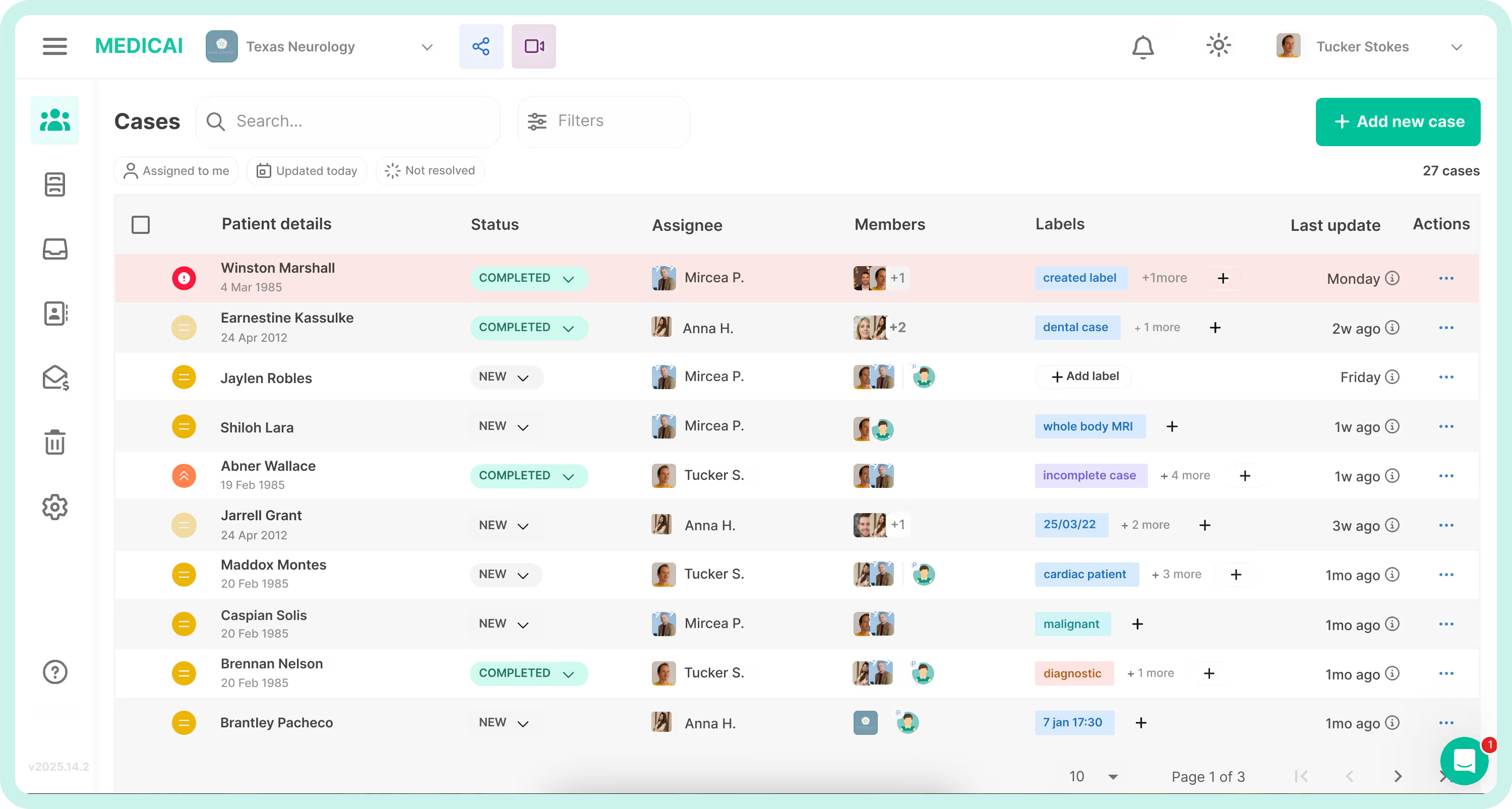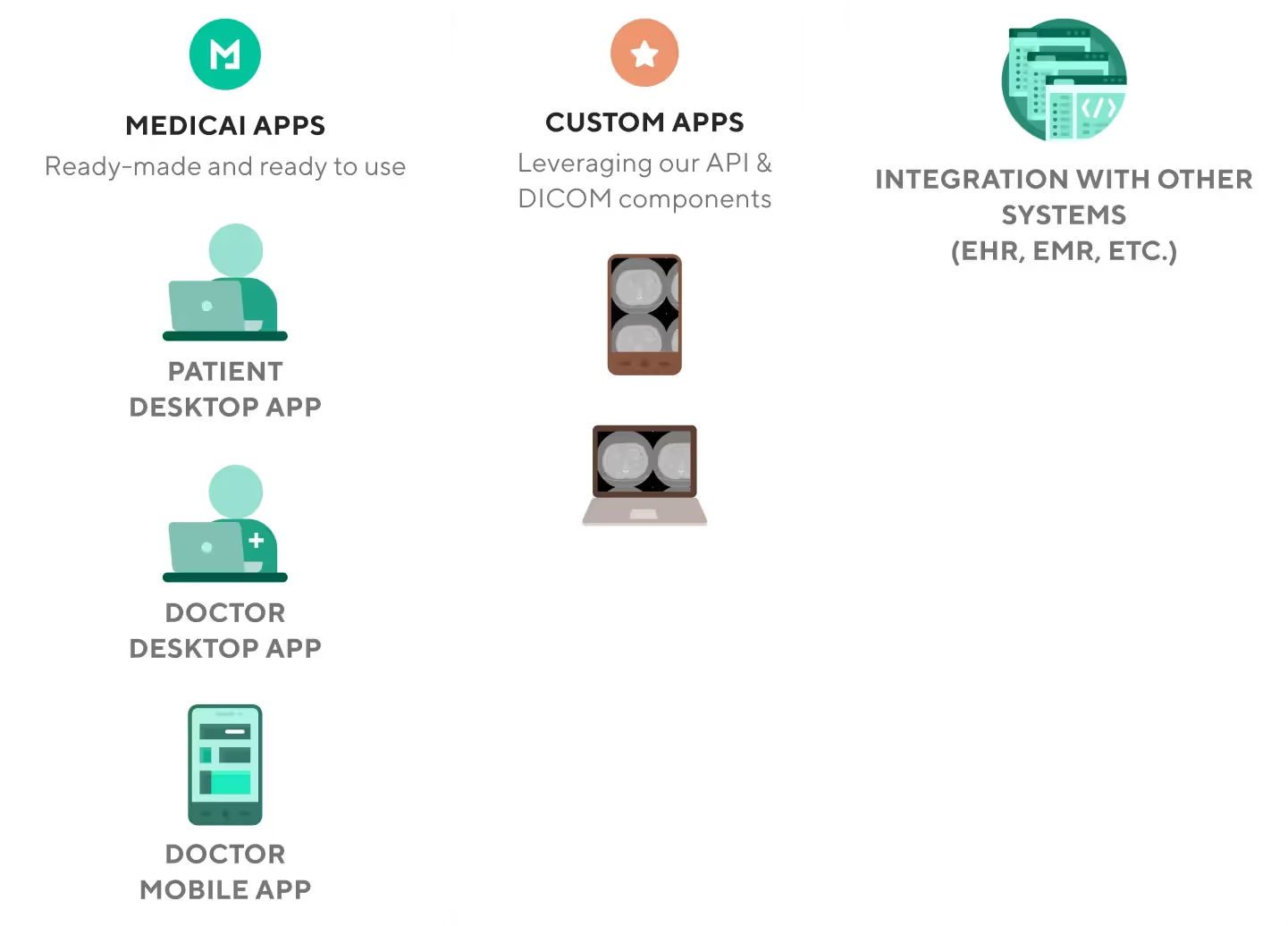Access, manage, and share images securely across multiple locations from any device. Our PACS software leverage AI for 50% faster reporting, intuitive imaging workflows, and enhanced patient care. Integrate with existing systems or build custom solutions with our API. Scale effortlessly and enjoy the freedom of cloud technology with Medicai cloud based PACS system.




Our cloud based PACS system streamline workflows, enhance collaboration, and improve patient experience with AI-powered tools and a user-friendly platform tailored to your specialty.
Radiologists can focus on what they do best—interpretation. Our cloud based radiology PACS integrated with AI tools and modern interface help radiologists to make their task easy by integrating PACS with RIS.
Access cardiology imaging from any location to facilitate seamless communication between cardiologists. Our PACS cardiology system ensuring timely diagnosis and treatment for cardiac patients.
Efficient imaging retrieval and AI-driven tools help streamline complex cancer diagnostics, enabling oncology specialists to provide quicker and more accurate oncology treatment plans for their patients.
MEDICAI’s platform delivers rapid, secure access to neurological imaging, supporting quick decision-making for critical conditions like strokes and neurological disorders.



Experience an intuitive, out-of-the-box solution with modern tools and zero-footprint DICOM Viewers. Connect multiple locations seamlessly with a unified web and mobile interface for instant access anywhere.
Deploy DICOM nodes remotely within hours, enabling instant data retrieval across your imaging partners. Enhance workflow efficiency and ensure consistent data access with ease.
Integrate imaging features directly into your existing doctor apps or develop new solutions from scratch. Our Imaging API brings ultimate flexibility to your medical software.
Leverage AI tools to reduce reporting time by 50%. Boost profit margins with advanced features like dictation, voice recognition, and automatic summarization—making reporting 2X faster and more accurate.
Choose from default or third-party FDA/CEE Cleared viewers like DICOM viewers like OsiriX, MedDream, and FlexView. Medicai integrates seamlessly to accommodate your radiologist’s preferences.
Access imaging data on the go with mobile apps for iOS and Android. Effortlessly scale your practice by increasing the number of doctors and customers without compromising efficiency.
Give it a try, play with it! Using our embeddable DICOM Viewer, you can easily view your DICOM files anywhere online (web, in the mobile application). Your DICOM files are stored in your Medicai workspace, in your cloud PACS.
If you are a patient and want to view your medical imaging (MRI, CTs, X Rays etc), you can instantly use our free online DICOM Viewer. You don't need to create any account, install any software or sign-up for a free trial.





"With Medicai's intuitive platform, I can seamlessly share cases, annotate images, and facilitate discussions, enhancing learning and collaboration within our community. It's truly a game-changer in advancing radiology education."
Sorin Ghiea

Forget VPNs and multiple accounts—MEDICAI connects all your locations securely in one platform. Enjoy a unified, scalable solution without the hassle, ensuring faster access to imaging and streamlined workflows.
Focus on what matters—interpretation. MEDICAI’s AI features make mundane tasks easy, allowing radiologists to dedicate more time to interpretation, driving growth and profitability for your practice.
Stop switching between multiple systems. We unify imaging access across locations, providing a single interface that saves time and eliminates confusion for doctors.
Easily integrate MEDICAI’s flexible API to expand your tech stack without massive costs or delays. Build or enhance solutions tailored to your practice needs.
Ensure doctors only access the imaging data they need. MEDICAI’s granular controls provide enhanced security, safeguarding patient data while ensuring efficiency.
Minimize time spent on repetitive tasks. MEDICAI automates reporting processes, enabling radiologists to focus on patient care, reducing report time, and improving throughput.
Use the DICOM Viewer that fits your radiologists’ preferences—MEDICAI integrates easily with popular third-party viewers like OsiriX (for macOS), MedDream and others, simplifying data transfer.
No more outdated software. MEDICAI provides a sleek, modern interface that’s user-friendly and ready for innovation, making it easier for staff to adapt and stay productive.
Take advantage of cutting-edge technologies like AI and large language models with MEDICAI’s innovation-ready platform, designed to help your practice stay ahead in a rapidly evolving industry.

Our multi-enterprise solution enables modern practices to automatically retreive imaging from their own local PACS and modalities, connect to partners and allow their patients to easily upload their previous imaging studies.

Our Cloud PACS is the central piece of software running on our scalable infrastructure. All the studies, together with complementary files (reports, images, videos) are stored in a secure and compliant way (HIPAA, GDPR).
The Cloud PACS has built in granular access control levels enabling precise sharing of data inside the organization, and outside.
Thanks to our robust API the imaging data is readily available. This makes implementation of advanced imaging workflows a breeze.

Team members can access, view, share and collaborate easily with our ready made web portal for doctors and mobile apps for doctors.
Tech-savvy practices practices leverage our APIs and our DICOM components to embed DICOM capabilities into their existing web portals, apps and software systems.

Medicai is fully HIPAA compliant and leverages Microsoft Azure's powerful infrastructure, which is HiTRUST and SOC2 certified. This ensures top-notch data security for your practice.
We uphold international quality and security standards with ISO 9001 and ISO 27001 certifications. Rest assured that our system meets the rigorous requirements for quality management and information security.
Data privacy is our priority. Medicai adheres to GDPR standards, ensuring data protection and privacy compliance across borders.
Choose trusted imaging viewers like MedDream and FlexView, both FDA approved for medical imaging—offering reliable tools to enhance diagnostic precision.
How does a PACS system use the DICOM standard?
A PACS system uses the DICOM standard to manage medical images. It helps healthcare providers store, retrieve, view, and share images from different devices. DICOM makes sure that images from CT, MRI, X-ray, and ultrasound machines are saved consistently. It provides seamless communication among imaging devices, workstations, and healthcare providers.
Can PACS integrate with EHRs used in urgent care clinics?
Yes. PACS can integrate with EHRs used in urgent care clinics through HL7 and DICOM standards. This setup makes imaging data, reports, and patient records sync easily which improves workflow, reduces manual entry, and provides quick access to complete clinical information for providers.
How do radiology information systems (RIS) and PACS work together?
RIS manages patient information, scheduling, and reporting. PACS stores and displays medical images like X-rays and MRIs. RIS handles the administrative tasks, while PACS manages imaging. Their integration enhances radiology workflow by improving efficiency, reducing errors, and speeding up diagnosis and report delivery in medical imaging departments.
Is there a difference in cost between on-premise and cloud PACS software?
On-premise PACS software usually has higher upfront costs for hardware, licensing, and IT setup. In contrast, cloud PACS has lower initial costs through subscription-based pricing, less infrastructure needs, and easy scalability. Over time, total costs can vary based on your usage, storage, and support requirements.
What is the role of PACS in teleradiology?
PACS supports teleradiology by storing, organizing, and sharing medical images like X-rays, CT scans, and MRIs. It helps radiologists to view scans remotely, compare them with previous studies, and quickly send reports. By centralizing image management, PACS quickens diagnoses, supports teamwork, and secures data sharing among hospitals, clinics, and specialists.
Why do cardiologists need a dedicated cardiology PACS system?
Cardiologists need a dedicated PACS because heart imaging involves unique data like echocardiograms, angiograms, and stress tests. A cardiology PACS manages these formats, supports advanced measurements, and integrates with cardiology workflow and EMR systems. It makes diagnosis, reporting, and treatment planning faster and more accurate.
How does a veterinary PACS system improve diagnostic imaging?
A veterinary PACS system improves imaging efficiency by centralizing storage and organization of X-rays, ultrasounds, CTs, and MRIs. It includes features like species-specific workflows, quick sharing with specialists, and secure cloud storage that promote treatment speed, accuracy, and better pet care in veterinary clinics and hospitals.
What are the differences between PACS vs VNA?
PACS stores and displays medical images for short to mid-term clinical use, while VNA focuses on long-term storage and interoperability, keeping data accessible even when switching PACS vendors. PACS handles daily imaging workflows; VNA makes sure image data stays organized, secure, and future-ready.
Is patient data safe during a PACS to PACS transfer?
Patient data is fully protected during PACS to PACS transfer of medical images and reports between systems for upgrades, vendor changes, or study sharing. To prevent unauthorized access and protect patient information, the system uses encryption, a secure network, and compliance with standards such as DICOM and HIPAA.
How does PACS work with DICOM?
PACS work for DICOM by storing, organizing, and sharing medical images in a central system. It helps doctors to access and view scans quickly, and to send DICOM files securely between hospitals, clinics, and specialists. Together, PACS and DICOM provide smooth collaboration and better patient care.
What is a cloud-based PACS?
A cloud-based PACS (Picture Archiving and Communication System) is a medical imaging technology that stores, retrieves, and manages medical images in the cloud, offering secure access from multiple locations.
How does a cloud-based PACS improve workflow efficiency?
It offers rapid multi-location connectivity, centralized image access, and AI-driven tools that automate mundane tasks, allowing radiologists to focus more on interpretation and patient care.
Is MEDICAI's cloud-based PACS secure?
Yes, MEDICAI's PACS is HIPAA and GDPR-compliant, uses Microsoft Azure infrastructure with HiTRUST and SOC2 certifications, and features granular access controls to ensure data security.
How is cloud-based PACS different from traditional PACS?
Unlike traditional PACS, which require on-premise servers and VPNs, cloud-based PACS offers scalable solutions and instant remote access, eliminating costly infrastructure.
Can Medicai's PACS integrate with our current systems?
Yes, MEDICAI’s flexible API can be integrated seamlessly with existing doctor apps and imaging systems, allowing for easy expansion of your tech stack.
Is the system compliant with industry regulations?
Absolutely. Our cloud-based PACS is HIPAA, GDPR, ISO 9001, and ISO 27001 compliant, ensuring data security and regulatory adherence.
What infrastructure supports Medicai's PACS?
Medicai's PACS runs on Microsoft Azure, which is HiTRUST and SOC2 certified, providing a robust and secure infrastructure for medical imaging data.
Is Medicai’s PACS ready for future technologies like AI and LLMs?
Yes, MEDICAI’s PACS is built to be innovation-ready, enabling healthcare practices to adopt and leverage cutting-edge technologies such as AI and large language models.
Seamlessly retrieve, view, store, and share medical imaging data with a robust multi-location, cloud PACS storage, zero-footprint DICOM viewers, AI support, and best-in-class sharing capabilities.
Other Medicai Products
CONNECT & RETRIEVE
STORE & MANAGE